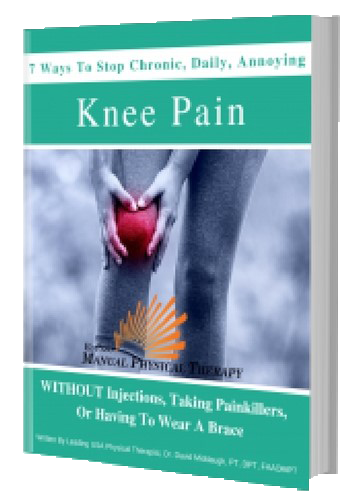TAP TO CALL (915) 503-1314

KNEE PAIN AFTER ACL SURGERY
Do you still have knee pain even though you had an ACL surgery to correct it? It’s one of the most frustrating things that I hear from people and they come in and they said, I had an ACL surgery and I’ve really aggravated it. I don’t know if I’ve messed up the surgery. I can’t play sports, it’s even hurting just when I’m sitting around when I am sleeping, and it bothers me, it swells. Now that’s a common problem. There’s clicking and shifting inside the knee joints.
Well, I’m going to explain to you why people get knee pain after having surgery today. My name is Dr. David Middaugh. And I’m a specialist physical therapist. This channel here is focused on helping people stay healthy, active, and mobile, while avoiding unnecessary surgery injection or medication. Please subscribe to our channel so that you don’t miss out on any of the helpful videos that we upload every single week. So let’s get to it.
Let me show you my picture here about knee pain and ACL surgeries. So in a knee, let me just orient you, these are the thigh bones up here on the top, you’ve got the left and the right. And then in blue right here, you’ve got the ACL ligaments ACL is anterior cruciate ligament. And then right here on the bottom, you’ve got the shin bones. And there’s the foot. without all the bones drawn, of course, it’s too much detail.
But what you got to know and notice the angle that I’ve drawn the ACL, those ligaments at, they start, they actually are in the back of the knee joint, and then they come forward and inwards to attach towards the front inward part of the shin bone.
So because of that angle, they are in prime position to be stretched out and then eventually tear if there’s an inward force on the knee, and I drew these arrows with kind of a circle here, because usually it’s a rotation, and an inward force problem that happens at the same time, I’ll show you on myself here in a minute.
But when that inwards force like your knees are coming in together, or it could be subtle, I’ll show you the subtleties of this. When that inward force happens repetitively over time, it just stretches out those ACLs. Even if you’ve had a surgery, you can get those ACLs stretched out over time. And that ACL is critically important for knee stability.
The job of the ACL, is to make sure that the thigh bone stays connected to the shin bone, along with some other ligaments, but especially when the knee goes inwards, like I was describing it so that the knee doesn’t come apart at that position.
So if you repetitively put your knee in that position where it comes inwards, and rotates inwards, then you’re going to stress that ACL ligament over and over again. And it’s just a matter of time before you injure it, or begin to lose stability in the knee joint.
That’s why you can get clicking or popping because the ligaments probably already stretched out, and it’s just not connected as tightly as it should. So the joint literally shifts and can pop and click, you can get pain as a result of this, you can begin to injure your meniscus, and other ligaments that also help support the knee also get overstretched because they don’t have the stability from the ACL that they should have.
So the motion that I’m talking about, stand up on the table here so that you can see what I mean is this this motion, whenever you bend your knees come inwards a bit, pay close attention. Because if every time you go to stand up and sit down, and if you sit down and then you stand up, a lot of people do this without even thinking about it, their knees come in, and then they come up. Now it’s not a big deal.
If you’re just standing you’re sitting. But let’s say you’re doing weights, exercises are jumping in every time you come down, you come down with your knees in instead of straight out or outwards like this or straight, then you’re going to tension that ACL, remember, it runs like this, and it runs from the back to the front. And from the outside to the inside going downwards and forwards in this direction.
So if you do this motion with your knee, consistently, then you’re just stretching out that ACL ligament repeatedly over time. Gosh, I even just feel it right there doing that motion. And it’s just a matter of time before you injured the meniscus, you stretch out your NCL the medial collateral ligament right here, or caused cartilage problems inside the knee because the the kneecap doesn’t track properly.
And of course, it can affect the hip and the foot and ankle as well. So I’ll put out another video that talks to you about how what exercises to do what concepts to think about with fixing an ACL injury like this a re injury after you’ve had surgery.
But it’s important for you to just understand the mechanism what I’m telling you right now the way that you’re doing it because not a single exercise will fix this for good. You’ve got to be thinking about how you stand up literally how you sit down and stand up in a chair.
If you do exercises, how do you move when you walk? How do you move when you run? How do you stop? If you’re lifting weights or doing any sort of squatting motion, virtually anything where you have to bend your hips and knees, you got to think about how you do it. And you do this all the time.
I mean, just think about sitting down the toilet or getting down onto the ground at home to tie your shoes or do something on the floor at home, you’ve got to begin to move where you don’t tension your ACL, which means you have to be shoving your knees more outwards, and not letting them collapse inwards. Now, this does tend to bother people more so that are that are stiffer in their joints.
So if you’ve been flexible your whole life, you’ve been able to reach your foot, you know up to your head or behind your head. They can tolerate this stretching quite a bit more before they have issues. But people that have very flexible ligaments still do run into this issue where they have knee pain after having an ACL injury or surgery.
And then people that are stiffer they they’re the ones that tend to snap through ACLs quicker with a sports injury or any kind of injury. And then they’ll reinjure it a bit quicker after they’ve had surgery if they hadn’t fixed their knees going inwards as a habitual motion as the way that they typically move. Something important to look at is foot strength as well and footwear.
If you’ve got a collapsed arts a flat foot, in other words, the medical term for that is Pez plainness, then you’ve got to figure out how to get your muscles stronger. And there’s two types of Pez plain as a flat foot, there’s a genetic one where you know, you’re just stuck like that no matter what, and then an acquired where you’ve developed it over time, and that can easily be fixed.
So wearing some supportive shoes, that helps to put your arch up, will help to turn your lower leg your shin up and position your knee better. But the fact of the matter is, you cannot rely on those things forever, you’ve got to develop your strength and your foot muscles in your arch. So that you don’t you can walk barefoot, you can do everything in life without stressing out your ACL over time.
And the worst reinjury that I’ve seen, just to paint you a picture in case you’ve got an ACL surgery in the past and you’re having some knee pain, the worst injuries come from people that do not exercise. So people that had had an ACL injury, say in high school and maybe a volleyball player or basketball or football player in high school ended for them and activity ended as well.
They’re not keeping up with sports like they used to maybe they’re in college or working and they’re not in, you know, sports and activity like they used to, then I go to the gym anymore, they tend to get a little weaker over time. And as the years go by maybe into their late 20s, early 30s.
The weakness comes on so much that if they do something a little active, they’ll get hurt the worst injury, I saw some woman in her 30s jumping on a trampoline. You know, she did sports in high school a bit had an ACL injury back then got it fixed, of course, they took a patellar graft, meaning they took a section of the tendon on the front of the knee which weakens the tendon.
Sometimes they’ll do a hamstring graft, or they’ll take a tendon from the hamstring. But you got to understand there, you’re sacrificing stability from some other part of your knee to gain that ACL stability. So overall makes your knee a bit weaker, it’s important to get strong and stay strong so that you can compensate for that weakness.
But if you don’t exercise and maintain some strength, then you’re setting yourself up. So anyway, she was on the trampoline with her small child jumping up and down and just jumped really high and landed down something that most people should be able to take.
And her knee just caved in words retour her ACL and had to have a second ACL reconstruction probably could have been avoided had she maintained some sort of fitness even just like a walk in routine or, you know, go to the gym once a week type of thing. And she knew it.
She was you know, she’s took full responsibility for it, but she’s doing tremendously better now. And she’s definitely on board with exercising consistently even though she doesn’t like it. You just got to deal with It’s like eating broccoli if you don’t like broccoli is a healthy thing for you most of the time.
But anyways guys, I hope this video was helpful for you. Stay tuned for a video on exercises that you can start to do if you’ve got knee pain, and you’ve had an ACL injury in the past so that you can protect your ACL moving forward even if it was operating on or not. You should make sure to manage your ACL so that it doesn’t get worse over time.
Thanks so much for watching guys. Give us a like you thought this video was helpful. drop any comments if you have questions. And also don’t forget to subscribe so that you don’t miss out on any of our helpful videos. Have a wonderful week guys.
Would You Like To Talk With A Specialist?
Appointments and Questions Call: (915)503-1314
EL PASO MANUAL PHYSICAL THERAPY
2601 E. Yandell Drive, Suite 232
El Paso, Texas 79903
© 2023 El Paso Manual Physical Therapy, PLLC, All Rights Reserved
